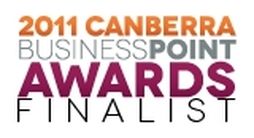QuietRush named as Finalist in ACT Clean+Green Business Awards category
Quiet Rush are pleased to announce the company has been named as a finalist in the Canberra Business Point 2011 Awards category for Clean and Green business in the ACT.

Quiet Rush were named as a finalist in the 2011 Canberra Business Point Awards last night, capping off a busy first quarter of operation.
We want to specifically recognise the support of Canberra Business Point and the ACT Government for their focus on assisting ACT startups. They're helping to demonstrate that, on top of Australia being ranked No.2 in the world for ease of starting a business, the ACT is a leading choice of location for entrepreneurs, despite its reputation as a government town.
We also want to acknowledge the support we receive from business mentors at Cordelta, who have a genuine focus on helping others succeed, with lightweight, low cost tools and advice for standing up a robust startup business platform. Having the capacity to get exposure and experience using other Australian designed tools like Atlassian's Confluence and Jira has been invaluable for our business.
Quiet Rush are pleased to announce the company has been named as a finalist in the Canberra Business Point 2011 Awards category for Clean and Green business in the ACT. The awards winners and finalists were announced 29 November at the Canberra Business Point Awards night. The Founder of Quiet Rush, Brian Hill, commented: "We are grateful for the support of Canberra Business Point and the ACT Government for their focus on assisting ACT startups. We also want to acknowledge the support we receive from business mentors at Cordelta, who have a genuine focus on helping others succeed, with lightweight, low cost tools and advice for standing up a robust startup business platform.
Our hybrid electric bikes are ideally suited to cities like Canberra where active transport is encouraged and supported. The bikes have been getting strong interest domestically and internationally from riders who understand the need for a swift, silent, simple, rugged, flexible and capable electric mountain bike.
They're also well suited to the needs of law enforcement, defence and border control agencies. There is such potential in lightly powered active transport options to address entrenched issues of traffic congestion, noise pollution, transport costs, inactive lifestyles and social isolation. Riding these bikes is an inherently quiet, socially engaging and pleasant experience. They're flexible enough to cater for unfit, inactive or elderly riders, family riders needing some power to help them in pulling a heavy load of kids and shopping in a bike-trailer through to highly experienced off-road riders looking for adventure.
We continue with our efforts to engage with the Australian Bicycle Council, Road Transport Authorities and advocate for a review of the Australian Road Rules bearing in mind that the current 200W limit, and proposed European 250W continuous/25km/h cutoff are overly restrictive if as a society we are serious about coming up with alternatives to car use. Applying a moped classification to a bicycle that is sufficiently lightly powered to take an average fitness rider to the individual time trial average of Cadel Evans doesn't make sense when unpowered bicycle riders can easily exceed the proposed 25/km/h cutoff.
Allowing lightly powered bikes to become part of the transport fabric is a necessary, but disruptive, innovation that takes policy courage mixed with a healthy dose of safety engineering. ATSB studies into cross modal safety comparisons have shown that bicycles are an inherently safer transport mode than many others. For instance, for Fatalities per passenger distance travelled (using UK data from 1999), whilst Motorcycles rated highest at 31.52, Pedestrian fatalities were higher (18.79) than bicycles (13.3) (a). This becomes more relevant when the convenience aspect of cycle usage is factored in, since route specificity is much higher for individual transport when compared to public transport options. We believe this indicates significant potential for greater utilisation of lightly powered bikes that are designed with safety engineering considerations from the start, without needing to approach them as having a risk profile equivalent to motorcycles.
We believe there is significant potential to be designing in higher design threshold speed limits of up to 50km/h, equivalent to elite cyclist averages, before applying threshold rules like classifying a bike as a motorcycle. Bear in mind that unpowered bicycles, ridden individually, can see riders achieve peaks on flat ground near 60km/h (b)(c) and higher when ridden in a peloton or downhill.
Comparing a lightly powered bike to motorcycles capable of 160km/h seriously hinders the innovation potential and capacity for sensible policy design in urban transport. Current standards are designed around the concept of single bike/single rider and fail to take into account the cycling needs of groups such as families with young children who have a higher load carrying need, whilst preserving safety margins and safe bicycle usage. "
References
(a) http://www.atsb.gov.au/media/36229/cross_modal_safety_comparisons.pdf

